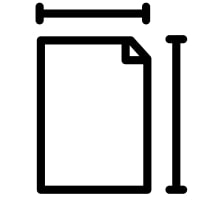
The idea of easy scaling of our standard paper sizes was 1st proposed by Lichtenberg
Date : 18/05/2024

When I clicked on the print command button on my computer to print the lecture notes, I found that the paper tray of my laser printer was empty. I immediately went to a nearby paper merchants shop and asked for a packet of printing papers. The merchant inquired whether I would like to have 70 GSM paper or a better quality (thicker) 80 GSM paper. In India, the standard size for printing paper on which most of the correspondence is printed is the A4 size (210 x 297 mm).
Many years back, as an Engineering student, I was supposed to do my Engineering and Machine Drawing assignment exercises on a A3 size (297 x 420 mm) paper. In the small town of Satara, where my college is situated, we used to get only A2 size (420 x 594 mm) drawing sheets. To get the desired size we used to halve the A2 sheet across the larger side to get two A3 size sheets. Same way when we halve the A3 sheet across its larger side we get 2 A4 size sheets. On the other hand, we can enlarge an A4 sheet to A3 size by doubling along its larger side.
The paper sizes are so designed that they can easily be upscaled or downscaled. Photocopy machines also usually use A size papers. You can photocopy an A3 size paper on an A4 size paper by 50% reduction without worrying that some text will be cut off. Also, you can photocopy an A4 sheet on an A3 sheet by 100% enlargement without having any extra margins left. For this to be possible the aspect ratio (the ratio of the larger side to the smaller side) of the paper size has to be constant for all sheet sizes.
Figure 1 (a)
Figure 1 (b)
Figure 1 (c)
My basic consideration while designing standard paper sizes is that they can easily be upscaled / downscaled. Let us consider a sheet of paper having dimensions a x b, where a is the larger side (refer Figure 1 (a)). To get a sheet of paper one size smaller we will fold/halve the paper across its longer side as shown in Figure 1 (b). The dimensions of the smaller sheet will be a/2 x b, where b is now the larger side (refer Figure 1 (c)). Now, we want the aspect ratio to be maintained. That is, we want the ratio of the larger side to the smaller side of the various paper sizes to be constant. Hence, we have
a / b = b / ((a/2))
(a^2) / 2 = b^2
a^2 = 2 (b^2)
(a^2) / (b^2) = 2
a / b = √2
Figure 2 (a)
Figure 2 (b)
To get a sheet one size bigger, we will double the paper along its larger side as shown in Figure 2 (a) and (b). We see that the dimensions of the bigger sheet are a x 2b, where 2b is the larger side. To maintain the aspect ratio, we want
a / b = 2b / a
a^2 = 2 (b^2)
(a^2) / (b^2) = 2
a / b = √2
This implies that for easy scaling of our standard paper sizes their aspect ratios have to be square root of two. This idea was first proposed by the German scientist and philosopher Georg Christoph Lichtenberg in the year 1786. In the early twentieth century, Dr. Walter Porstmann implemented Lichtenberg’s idea into a system of standard paper sizes. The international paper size standard, ISO 216, is based on Dr. Porstmann’s system.
Recall that when I went to purchase a pack of printing papers the paper merchant had asked whether I want a 70 GSM or a 80 GSM paper. Now what is GSM?
The full form of GSM is Grams per Square Metre. One square metre is the area of the largest paper sheet, A0. Dimensions of A0 size paper sheet are 841 x 1189 mm. 841 x 1189 = 999, 949 sq mm = 1 sq m (approximately). So GSM is the weight of the A0 size sheet. Now, we can get 16 A4 size sheets from one A0 size sheet. Hence, if we purchase a pack of 80 GSM A4 size paper sheets, the weight of each sheet will be 80 / 16 = 5 grams.
Aspect ratio of A0 sheet = 1189 / 841 = 1.413793 = √2 (approx)
√2 = 1.414213
Tags :
Note: Your email address will not be displayed with the comment.